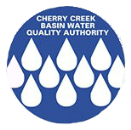Bubble Plume Model
Key Takeaways:
In 2019, a bubble plume model was coupled with the Reservoir model to mechanistically simulate the effects of the destratification system on mixing in Cherry Creek Reservoir. This allowed for a more realistic representation of the destratification system, and allows the model to be used for evaluating proposed modifications to the existing system and operations.
The modeling resulted in the following findings:
Due to continued water quality concerns, a water quality model of the Reservoir was developed to:
- Additional air flow and/or additional diffuser heads result in lower chlorophyll a concentrations.
- As the total system air flow increases, the additional decrease in chlorophyll a concentration decreases, leading to diminishing returns.
- The magnitude of the reduction in chlorophyll a differs from year to year. Factors that affect this include water temperature, reservoir storage volume, nutrient ratios, and the timing and magnitude of external nutrient loading.
- The simulated decreases in chlorophyll a concentrations with an expanded destratification system are not large enough to meet the chlorophyll a standard in all years, even with 50x the air flow of the existing system.
- The use of a compressed air destratification system to successfully control algae growth is limited in Cherry Creek by the shallow reservoir depth, large surface area, and high external nutrient loading.
Why a Bubble Plume Model?
The current version of the Cherry Creek Reservoir Water-Quality Model was developed using CE-QUAL-W2, version 3.71. The model accounts for artificial mixing in a simplified manner, in that mixing by the destratification system is simulated as a multiplier on vertical mixing in the depth interval above the diffusers. While the original Reservoir model included representation of the destratification system, bubble plume dynamics are not directly simulated. Use of the coupled bubble-plume model provides a more mechanistic simulation of the existing system and the ability to evaluate the water-quality response to specific design modifications.
Useful Links

Question
What would be the effectiveness of the existing destratification system if compressor shutdowns could be avoided?
Answer
Even if the air compressor was able to operate continuously without shutdowns there would be little additional effect on bottom DO and chlorophyll a concentrations
Question
What would be the benefit of increased air flow rates to the existing array of diffuser heads?
Answer
There is limited benefit to bottom DO and average chlorophyll a concentrations with additional air flow to the existing diffuser heads, even with 10 times the air flow of the existing system
Question
What would be the benefit of increasing both the number of diffuser heads and the flow rate to each of the diffuser heads?
Answer
Simulation results show that increasing the number of diffuser heads (with the same flow per head as current operations) results in increased bottom DO concentrations and decreased July – September average chlorophyll a concentrations. As the total system air flow increases, the additional decrease in chlorophyll a concentration decreases, leading to diminishing returns.
Question
Can the chlorophyll a standard be met with an enlarged destratification system?
Answer
Based on the 22 scenarios considered, the coupled model suggests that the chlorophyll a standard cannot be met in all years by enlarging the destratification system. Even with a 50-fold increase in air flow capacity, the simulated July – September average chlorophyll a concentration decreased by an average of 3.7 μg/L
